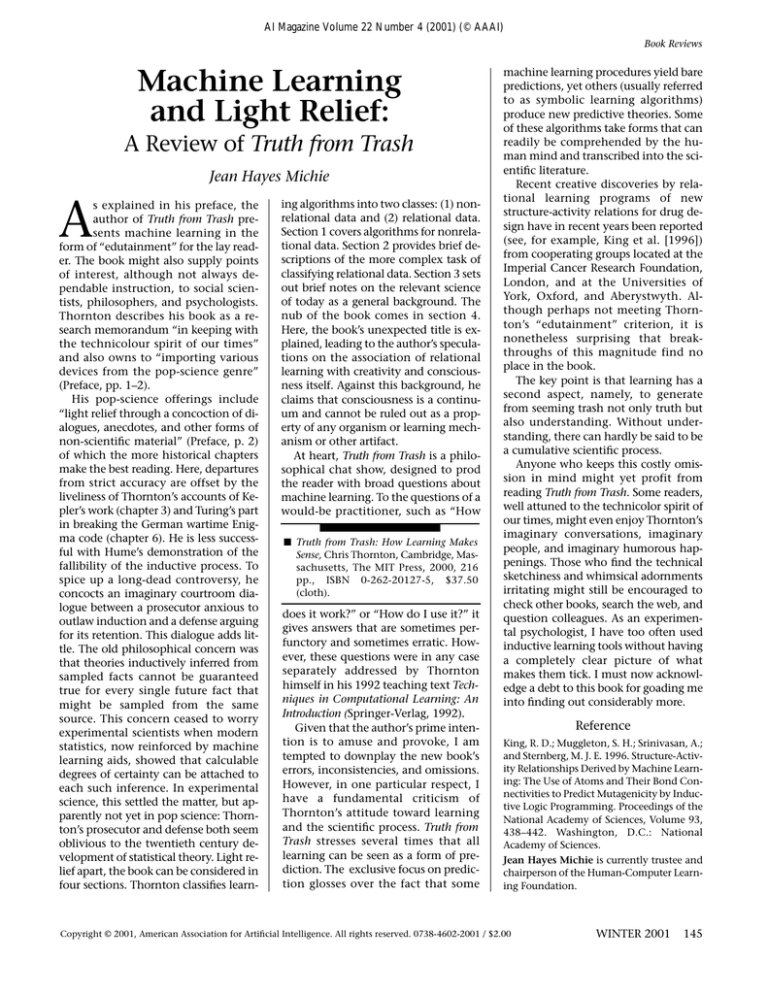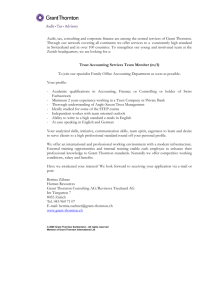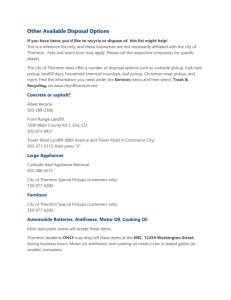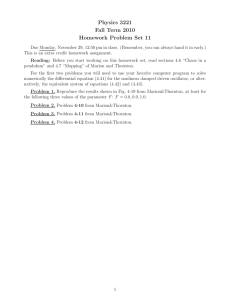
AI Magazine Volume 22 Number 4 (2001) (© AAAI)
Book Reviews
Machine Learning
and Light Relief:
A Review of Truth from Trash
Jean Hayes Michie
A
s explained in his preface, the
author of Truth from Trash presents machine learning in the
form of “edutainment” for the lay reader. The book might also supply points
of interest, although not always dependable instruction, to social scientists, philosophers, and psychologists.
Thornton describes his book as a research memorandum “in keeping with
the technicolour spirit of our times”
and also owns to “importing various
devices from the pop-science genre”
(Preface, pp. 1–2).
His pop-science offerings include
“light relief through a concoction of dialogues, anecdotes, and other forms of
non-scientific material” (Preface, p. 2)
of which the more historical chapters
make the best reading. Here, departures
from strict accuracy are offset by the
liveliness of Thornton’s accounts of Kepler’s work (chapter 3) and Turing’s part
in breaking the German wartime Enigma code (chapter 6). He is less successful with Hume’s demonstration of the
fallibility of the inductive process. To
spice up a long-dead controversy, he
concocts an imaginary courtroom dialogue between a prosecutor anxious to
outlaw induction and a defense arguing
for its retention. This dialogue adds little. The old philosophical concern was
that theories inductively inferred from
sampled facts cannot be guaranteed
true for every single future fact that
might be sampled from the same
source. This concern ceased to worry
experimental scientists when modern
statistics, now reinforced by machine
learning aids, showed that calculable
degrees of certainty can be attached to
each such inference. In experimental
science, this settled the matter, but apparently not yet in pop science: Thornton’s prosecutor and defense both seem
oblivious to the twentieth century development of statistical theory. Light relief apart, the book can be considered in
four sections. Thornton classifies learn-
ing algorithms into two classes: (1) nonrelational data and (2) relational data.
Section 1 covers algorithms for nonrelational data. Section 2 provides brief descriptions of the more complex task of
classifying relational data. Section 3 sets
out brief notes on the relevant science
of today as a general background. The
nub of the book comes in section 4.
Here, the book’s unexpected title is explained, leading to the author’s speculations on the association of relational
learning with creativity and consciousness itself. Against this background, he
claims that consciousness is a continuum and cannot be ruled out as a property of any organism or learning mechanism or other artifact.
At heart, Truth from Trash is a philosophical chat show, designed to prod
the reader with broad questions about
machine learning. To the questions of a
would-be practitioner, such as “How
■ Truth from Trash: How Learning Makes
Sense, Chris Thornton, Cambridge, Massachusetts, The MIT Press, 2000, 216
pp., ISBN 0-262-20127-5, $37.50
(cloth).
does it work?” or “How do I use it?” it
gives answers that are sometimes perfunctory and sometimes erratic. However, these questions were in any case
separately addressed by Thornton
himself in his 1992 teaching text Techniques in Computational Learning: An
Introduction (Springer-Verlag, 1992).
Given that the author’s prime intention is to amuse and provoke, I am
tempted to downplay the new book’s
errors, inconsistencies, and omissions.
However, in one particular respect, I
have a fundamental criticism of
Thornton’s attitude toward learning
and the scientific process. Truth from
Trash stresses several times that all
learning can be seen as a form of prediction. The exclusive focus on prediction glosses over the fact that some
machine learning procedures yield bare
predictions, yet others (usually referred
to as symbolic learning algorithms)
produce new predictive theories. Some
of these algorithms take forms that can
readily be comprehended by the human mind and transcribed into the scientific literature.
Recent creative discoveries by relational learning programs of new
structure-activity relations for drug design have in recent years been reported
(see, for example, King et al. [1996])
from cooperating groups located at the
Imperial Cancer Research Foundation,
London, and at the Universities of
York, Oxford, and Aberystwyth. Although perhaps not meeting Thornton’s “edutainment” criterion, it is
nonetheless surprising that breakthroughs of this magnitude find no
place in the book.
The key point is that learning has a
second aspect, namely, to generate
from seeming trash not only truth but
also understanding. Without understanding, there can hardly be said to be
a cumulative scientific process.
Anyone who keeps this costly omission in mind might yet profit from
reading Truth from Trash. Some readers,
well attuned to the technicolor spirit of
our times, might even enjoy Thornton’s
imaginary conversations, imaginary
people, and imaginary humorous happenings. Those who find the technical
sketchiness and whimsical adornments
irritating might still be encouraged to
check other books, search the web, and
question colleagues. As an experimental psychologist, I have too often used
inductive learning tools without having
a completely clear picture of what
makes them tick. I must now acknowledge a debt to this book for goading me
into finding out considerably more.
Reference
King, R. D.; Muggleton, S. H.; Srinivasan, A.;
and Sternberg, M. J. E. 1996. Structure-Activity Relationships Derived by Machine Learning: The Use of Atoms and Their Bond Connectivities to Predict Mutagenicity by Inductive Logic Programming. Proceedings of the
National Academy of Sciences, Volume 93,
438–442. Washington, D.C.: National
Academy of Sciences.
Jean Hayes Michie is currently trustee and
chairperson of the Human-Computer Learning Foundation.
Copyright © 2001, American Association for Artificial Intelligence. All rights reserved. 0738-4602-2001 / $2.00
WINTER 2001
145




